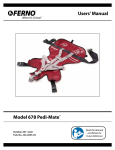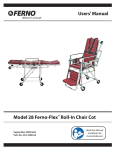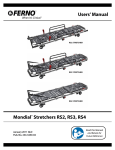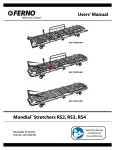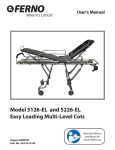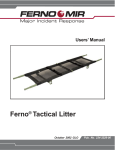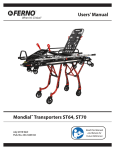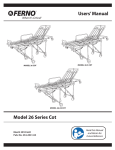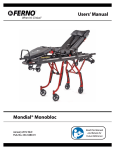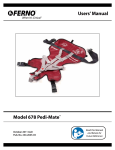Download FERNO Users` Manual
Transcript
FERNO ® When It’s Critical ® Users’ Manual Model 418-1 Adjustable Lifting Bridle September, 2010 GLO Pub. No. 234-0234-04 Read this Manual and Retain for Future Reference Model 418-1 Lifting Bridle Ferno Technical Support Disclaimer Customer service and product support are important aspects of each Ferno product. For technical support questions: Telephone (Toll-free) 1.800.733.3766 ext. 1010 Telephone 1.937.382.1451 ext. 1010 This manual contains general instructions for the use, operation and care of this product. The instructions are not all-inclusive. Safe and proper use of this product is solely at the discretion of the user. Safety information is included as a service to the user. All other safety measures taken by the user should be within and under consideration of applicable regulations. It is recommended that training on the proper use of this product be provided before using this product in an actual situation. Email [email protected] Ferno Customer Relations Retain this manual for future reference. Include it with the product in the event of transfer to new users. Additional free copies are available upon request from Customer Relations. For ordering assistance or general information: Canada and the U.S.A. Telephone (Toll-free) Telephone Fax (Toll-free) Fax 1.877.733.0911 1.937.382.1451 1.888.388.1349 1.937.382.1191 Internet www.ferno.com All Other Locations For assistance or information, please contact your Ferno distributor. If you do not have a Ferno distributor, please contact Ferno Customer Relations: Ferno-Washington, Inc. 70 Weil Way Telephone Fax Internet Wilmington, Ohio 45177-9371, U.S.A. +1.937.382.1451 +1.937.382.6569 Proprietary Notice The information disclosed in this manual is the property of FernoWashington, Inc., Wilmington, Ohio, USA. Ferno-Washington, Inc. reserves all patent rights, proprietary design rights, manufacturing rights, reproduction use rights, and sales use rights thereto, and to any article disclosed therein except to the extent those rights are expressly granted to others or where not applicable to vendor proprietary parts. Limited Warranty Statement The products sold by Ferno are covered by a limited warranty, which is printed on all Ferno invoices. The complete terms and conditions of the limited warranty, and the limitations of liability and disclaimers, are also available upon request by calling Ferno at 1.800.733.3766 or 1.937.382.1451. www.ferno.com European Representative Ferno (UK) Limited Stubs Beck Lane, Cleckheaton West Yorkshire BD19 4TZ, United Kingdom Telephone +44 (0) 1274 851999 Fax +44 (0) 1274 851111 Internet www.ferno.co.uk users’ manual To request additional free users’ manuals, contact Ferno Customer Relations, your Ferno distributor, or visit www.ferno.com. © Copyright Ferno-Washington, Inc. All Rights Reserved. 2 © Ferno-Washington, Inc 234-0234-04 September 2010 Model 418-1 Lifting Bridle Table of Contents Section Page Ferno Customer Relations_______________________ 2 Ferno Technical Support________________________ 2 1 - Safety Information____________________________ 4 1.1 Warning_________________________________ 4 1.2 Important________________________________ 4 1.3 Bloodborne Disease Notice__________________ 4 1.4 Safety and Instruction Labels________________ 4 1.5 Symbol Glossary__________________________ 4 2 - Operator Skills and Training___________________ 5 2.1 Skills___________________________________ 5 2.2 Training_________________________________ 5 3 - About the Bridle______________________________ 6 3.1 Description______________________________ 6 3.2 General Specifications_ ____________________ 6 3.3 Bridle Components________________________ 6 © Ferno-Washington, Inc 234-0234-04 September 2010 Section Page 4 - Bridle Features_______________________________ 7 4.1 Color-Coded Webbing_ ____________________ 7 4.2 Bridle Length Adjustment___________________ 7 4.3 Carabiners _ _____________________________ 8 5 - Using the Bridle______________________________ 9 5.1 Before Placing the Bridle in Service___________ 9 5.2 General Guidelines for Use__________________ 9 5.3 Horizontal Lifting/Lowering________________ 10 5.4 Vertical Lifting/Lowering__________________ 11 6 - Maintaining the Bridle_ ______________________ 12 6.1 Maintenance Schedule_ ___________________ 12 6.2 Disinfecting and Cleaning the Bridle_________ 12 6.3 Lubricating the Carabiners_________________ 12 6.4 Inspecting the Bridle______________________ 13 6.5 Storing the Bridle________________________ 13 Training Record_ ______________________________ 14 Maintenance Record____________________________ 15 3 Model 418-1 Lifting Bridle Safety Information 1 - Safety Information 1.1 Warning 1.4Safety and Instruction Labels Warning notices indicate a potentially hazardous situation which, if not avoided, could result in injury or death. Safety and instruction labels place important information from the users’ manual on the bridle. The label below is affixed to two legs of the bridle. Warning Untrained operators can cause injury or be injured. Permit only trained personnel to operate the bridle. Improper use of the bridle can cause injury. Use the bridle only for the purpose described in this manual. BRIDLE CAPACITY 600 LB/272 KG TOTAL WEIGHT Improper operation can cause injury. Operate the bridle only as described in this manual. An unrestrained or improperly restrained patient can be injured. Secure the patient in the basket stretcher with a restraint system suitable to the rescue situation. Modifying the bridle can cause injury and damage. Use the bridle only as manufactured by Ferno. Improper maintenance can cause injury. Maintain the bridle only as described in this manual. 1.5Symbol Glossary The symbols defined below are used on the bridle and in this users’ manual. Ferno uses symbols recognized by the International Standards Organization (ISO), American National Standards Institute (ANSI) and the emergency medical services industry. 1.2Important Important notices emphasize important usage or maintenance information. Important 600 lb 272 kg General Warning of Potential Injury Standard Load Limit Read the Users’ Manual Product meets European Union Standards 1.3 Bloodborne Disease Notice To reduce the risk of exposure to bloodborne diseases such as HIV-1 and hepatitis when using the bridle, follow the disinfecting and cleaning instructions in this manual. 4 © Ferno-Washington, Inc 234-0234-04 September 2010 Model 418-1 Lifting Bridle Operator Skills and Training 2 - Operator Skills and Training 2.1Skills Operators using the bridle need: ● a working knowledge of emergency patient-handling procedures. ● the ability to assist the patient. 2.2 Training Operator trainees need to: ● receive professional instruction and training in rescue procedures using lifting bridles. ● read and understand this manual. ● be trained on the use of the bridle. ● practice with the bridle before using it with a patient. ● record their training information. A sample training record sheet is provided on page 14. © Ferno-Washington, Inc 234-0234-04 September 2010 Warning Untrained operators can cause injury or be injured. Permit only trained personnel to operate the bridle. Important Rescue procedures using the lifting bridle require special skills and are potentially hazardous activities. No rescue personnel should attempt such rescue procedures unless they have received professional instruction and training. 5 Model 418-1 Lifting Bridle About the Bridle 3 - About the Bridle 3.1 Description 3.2 General Specifications The Model 418-1 Adjustable Lifting Bridle (called the bridle in this manual) is designed to be used as an interface between a basket stretcher and a rope hoist, cable, or other lifting device. “D” Lift Ring 3" x 2-5/8" (76 mm x 67 mm) Webbing Width 1-¾" and 1" (44 mm and 25 mm) Leg Length Lift Ring to Carabiner 54-½" (1384 mm) Individual Legs 34-½" (876 mm) Range of Adjustment 11" (279 mm) per branch Leg Separation 100" (254 cm) maximum between gray and orange legs Temperature Range -40°F to 140°F (-40°C to 60°C) Weight 5 lb (2 kg) Load Limit 600 lb (272 kg) The bridle is compatible with the Ferno® Models 71, 71-S, and 71-SS Basket Stretchers. Warning Improper use of the bridle can cause injury. Use the bridle only for the purpose described in this manual. Load Limit 600 lb 272 kg General specifications are rounded to the nearest whole number. Metric conversions are calculated before rounding the Imperial measurements. For more information, contact Ferno Customer Relations (page 2) or your Ferno distributor. Ferno reserves the right to change specifications without notice. Inspect the bridle if the load limit has been exceeded (See Inspecting the Bridle, page 13). 3.3 Bridle Components Locking Carabiner (4) Leg (4) “V” Ring with Adjustment Assembly (2) Branch (2) Storage Pouch (not to scale) 6 Lift Ring Users’ Manual 234-0234 © Ferno-Washington, Inc 234-0234-04 September 2010 Model 418-1 Lifting Bridle Bridle Features 4 - Bridle Features 4.1 Color-Coded Webbing The center section of the bridle divides into two branches of 1-¾ in. (44 mm) webbing. Each branch terminates with a “V” ring assembly that serves two purposes: it is used to adjust the branch length, and it is the attachment point for two legs of one-inch (25 mm) webbing. Gray Legs Orange Legs The pair of legs attached to one branch is orange and the pair of legs attached to the other branch is gray. For horizontal lifting, attach the orange legs to the grommets on opposite sides of one end of the stretcher, and attach the gray legs to the grommets on opposite sides of the other end of the stretcher (Figure 1). This arrangement allows adjustment of the bridle length but keeps the stretcher level side-to-side. Important Do not attach straps of the same color to the same side of the stretcher. Doing so will cause the stretcher to tilt to one side when the straps are shortened or lengthened. Always attach straps of the same color to the same end of the stretcher. Figure 1 - Placement of Color-Coded Legs 4.2 Bridle Length Adjustment Adjusting the length of a branch changes the elevation at the end of the stretcher attached to that branch. The length of each branch of the bridle may be shortened as much as 11 in. (279 mm). shortening the bridle To shorten a branch of the bridle, hold the “V” ring perpendicular to the webbing and pull the bottom layer of webbing backward through the “V”-ring slide assembly until the branch is the desired length (Figure 2). Pulling the bottom layer of webbing allows the slack portion of webbing to hang toward the inside of the bridle where it is less likely to snag on elements encountered in a rescue situation. Figure 2 - Shortening the Bridle returning the bridle to full length To return a branch of the bridle to its full length, grasp the branch with one hand and with the other hand pull the “V” ring until no slack remains in the branch webbing (Figure 3). Figure 3 - Returning the Bridle To Full Length © Ferno-Washington, Inc 234-0234-04 September 2010 7 Model 418-1 Lifting Bridle Bridle Features 4.3 Carabiners Each bridle leg terminates with a locking carabiner (Figure 4). To open the carabiner: Locking Sleeve 1. Rotate the screw-type locking sleeve to uncover the nose. Nose 2. Squeeze the gate open and slide the nose of the carabiner through a tie-in point (grommet) on the basket stretcher (Figure 5). Note: Normally, a carabiner is oriented with the gate toward the inside of the stretcher to prevent the gate being opened by rubbing against a cliff face, building, rock or other element encountered during a rescue. However, certain situations may dictate the opposite orientation. It is the responsibility of the user to know which orientation is best suited to a given situation. To secure the carabiner: Gate Spine Hinge Figure 4 - Carabiner Components 1. Release the gate. 2. Rotate the locking sleeve until it covers the nose and stops traveling (Figure 6). Figure 5 - Attach the Carabiner With the Gate Facing the Inside of the Stretcher Locking Sleeve Figure 6 - Carabiner Gate Locked Closed 8 © Ferno-Washington, Inc 234-0234-04 September 2010 Using the Bridle Model 418-1 Lifting Bridle 5 - Using the Bridle 5.1 Before Placing the Bridle in Service ● Personnel who will work with the bridle need to read this manual. ● Confirm that the bridle operates properly by operating it according to instructions in Bridle Features, pages 7 and 8, and Inspecting the Bridle, page 13. 5.2 General Guidelines for Use ● ● Rescue procedures using the lifting bridle require special skills and are potentially hazardous activities. No rescue personnel should attempt such rescue procedures unless they have received professional instruction and training. Because rescue situations are rarely the same, this manual must be general in nature. It is the responsibility of personnel specially trained in technical rescue to know the techniques involved and to select the lifting equipment, stretcher, and patient restraint system suitable for each rescue situation. ● Make sure all equipment used with the bridle has a load rating at least equivalent to that of the bridle. ● Anytime a bridle is used in conjunction with a stretcher to lift a victim, the stretcher may be suspended horizontally, vertically, or at an angle, and rescuers may slide or carry it at various angles. Secure the patient in the stretcher so that he or she does not slip lengthwise, slide from side to side, or come out of the stretcher. © Ferno-Washington, Inc 234-0234-04 September 2010 Warning Improper operation can cause injury. Operate the bridle only as described in this manual. Warning An unrestrained or improperly restrained patient can be injured. Secure the patient in the basket stretcher with a restraint system suitable to the rescue situation. Warning Modifying the bridle can cause injury and damage. Use the bridle only as manufactured by Ferno. Important Rescue procedures using lifting bridles and other specialized gear are considered technical in nature. They are potentially hazardous activities and require special skills. No rescue personnel should attempt technical rescue procedures unless they have received professional instruction and training. Important Personnel using the bridle in a technical-rescue situation are responsible for knowing the techniques involved and for selecting the bridle, stretcher, and patient restraint system best suited to the rescue situation. 9 Model 418-1 Lifting Bridle Using the Bridle 5.3Horizontal Lifting/Lowering Read the General Guidelines for Use, page 9, before using the bridle. using the color-coded webbing Gray Legs Orange Legs For proper hookup, both orange legs must be attached to opposite sides of the same end of the stretcher (either the head end or the foot end) and both gray legs must be attached to opposite sides of the other end of the stretcher (Figure 7). See page 7 for more information about the colorcoded webbing. Important Do not attach webbing of the same color to the same side of the stretcher. Doing so can cause the stretcher to tilt to one side when the bridle length is adjusted. Always attach webbing of the same color to the same end of the stretcher. Figure 7 - Attaching the Orange and Gray Legs At Opposite Ends of the Stretcher attaching the carabiners The Ferno Models 71, 71-S, and 71-SS Basket Stretchers are fitted with four grommetted tie-in points for the bridle (Figure 8). ® Attach the carabiners to the tie-in points (see page 8 for carabiner operating instructions). Tie-in points on basket stretchers not manufactured by FernoWashington, Inc., may vary in type and location. Follow the stretcher manufacturer’s instructions for choosing and using tie-in points. Adjust the length of the branch webbing until the basket stretcher is level. See length adjustment instructions on page 7. Grommet Figure 8 - Grommets at Tie-In Points on the Ferno® Models 71, 71-S, and 71-SS Basket Stretchers using tag lines Attach tag lines to the stretcher to allow rescuers to position or maneuver the stretcher and to prevent it from spinning (Figure 9). Orange Legs Tag Line Gray Legs Tag Line Figure 9 - Horizontal Lifting/Lowering 10 © Ferno-Washington, Inc 234-0234-04 September 2010 Model 418-1 Lifting Bridle Using the Bridle 5.4Vertical Lifting/Lowering Read the General Guidelines for Use, page 9, before using the bridle. using the color-coded webbing For vertical lifting, tie-in points on Ferno® Models 71, 71-S, and 71-SS Basket Stretchers are the head-end handholds. For proper hookup, use all four legs of the bridle, placing an orange leg and a gray leg at each of the two head-end handholds (Figure 10.) Orange Leg and Gray Leg Orange Leg and Gray Leg attaching the carabiners To attach a leg, open the carabiner gate, slide the carabiner nose through the handhold opening, and lock the carabiner around the basket rim and metal frame. See page 8 for carabiner operating instructions. Adjust the length of the branch webbing until the weight of the basket stretcher is held equally by each leg pair. Tie-in points on stretchers not manufactured by FernoWashington, Inc., may vary in type and location. Follow the stretcher manufacturer’s instructions for choosing and using tie-in points. tag lines Attach tag lines to the stretcher to allow rescuers to position or maneuver the stretcher and to prevent it from spinning (Figure 10). Tag Line Tag Line Figure 10 - Vertical Lifting/ Lowering © Ferno-Washington, Inc 234-0234-04 September 2010 11 Maintaining the Bridle Model 418-1 Lifting Bridle 6 - Maintaining the Bridle 6.1 Maintenance Schedule The bridle requires regular maintenance. Set up and follow a maintenance schedule. The table at right represents minimum intervals for maintenance. Warning Improper maintenance can cause injury. Maintain the bridle only as described in this manual. Disinfecting (this page) 6.2 Disinfecting and Cleaning the Bridle 1. Remove the bridle from the basket stretcher. 2. To disinfect: Apply disinfectant to all surfaces of the bridle, following the manufacturer’s instructions for application method and contact time. 3. To clean: ○○ Wash the bridle by hand using warm, soapy water. ○○ Rinse in clear water. ○○ Use towels to squeeze excess water from the webbing and to wipe excess water from the hardware and carabiners. ○○ Hang the bridle in a warm place to dry. ○○ When webbing, hardware, and carabiners are completely dry, lubricate the carabiners as described below. • Cleaning (this page) Lubricating (this page) Inspecting (page 13) • Each Month Minimum Maintenance Intervals As Needed When using maintenance products, follow the manufacturers’ directions and read the manufacturers’ material safety data sheets. You can purchase a recommended disinfectant from your Ferno distributor or Ferno Customer Relations (page 2). Each Use Keep maintenance records. A sample maintenance record sheet is provided on page 15. • • Important Disinfectants and cleaners containing bleach, phenolics, or iodines can cause damage. Do not use products containing these chemicals. 6.3 Lubricating the Carabiners As needed, lubricate the carabiner hinge pins, latches, springs, and locking sleeves using a multi-purpose grease, or a synthetic lubricant such as WRL-191S. Use a small amount of lubricant. Wipe off excess lubricant. 12 © Ferno-Washington, Inc 234-0234-04 September 2010 Model 418-1 Lifting Bridle Maintenance 6.4Inspecting the Bridle After each use, have your service’s equipment maintenance personnel inspect the bridle, following the checklist at right. If inspection shows damage or excessive wear, remove the bridle from service and replace it with a new bridle. inspection checklist ● Are all components present? ● Is all webbing in good condition with no cuts or frayed edges? ● Is webbing stitching in good condition with no frayed or broken threads? ● Are the “V” rings and lift ring true to their original forms and free of cracks, deep scratches, and gouges? ● Do moving parts of the “V” rings move smoothly? ● Are the carabiners true to their original form? ● Are the carabiners free of cracks, deep scratches, and gouges? (Check to make sure that what appears to be a scratch is not actually a crack.) ● Are carabiner hinge pins securely in place? ● Do the carabiner locking sleeves turn smoothly and latch the gates securely? 6.5Storing the Bridle Store the bridle in a dry place, away from direct sunlight. © Ferno-Washington, Inc 234-0234-04 September 2010 13 Model 418-1 Lifting Bridle Training Record Date 14 Name Training Method © Ferno-Washington, Inc 234-0234-04 September 2010 Model 418-1 Lifting Bridle Maintenance Record Date Maintenance Performed © Ferno-Washington, Inc 234-0234-04 September 2010 By 15















